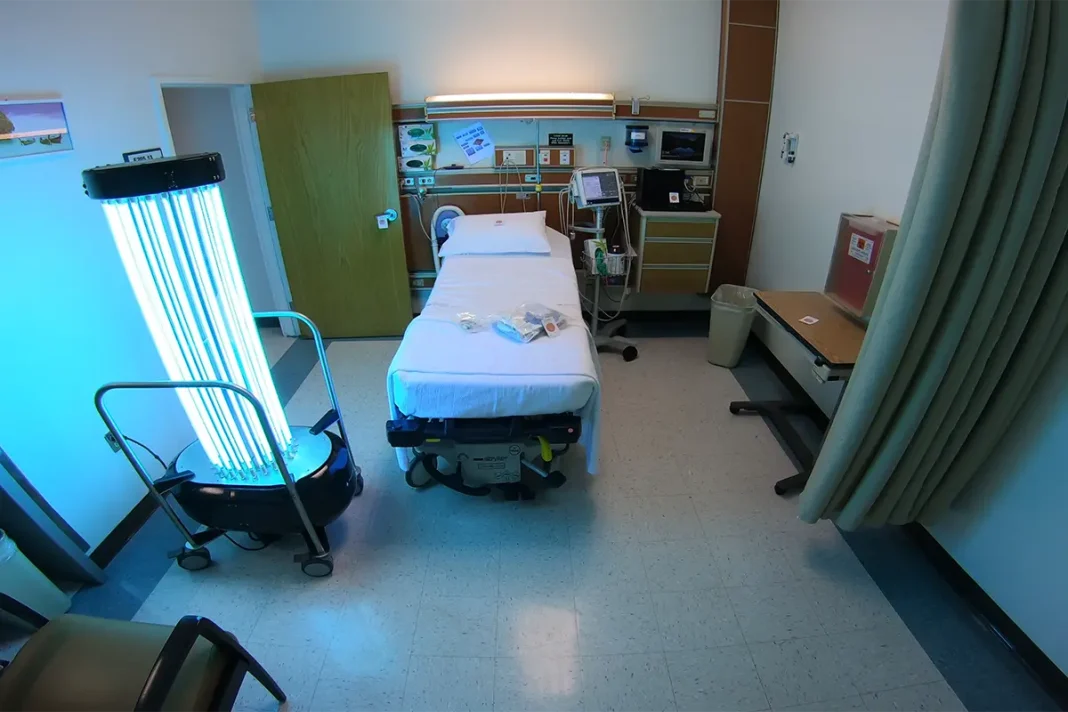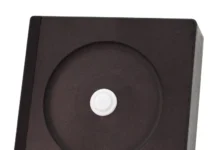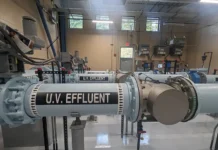Katja Auer, MA, MBA Clinical Director-Healthcare Division, American Ultraviolet
The mobile UV-C market has exploded with a plethora of UV-C devices, ranging from handheld UV-C disinfection wands, to UV-C chambers and an ever-growing selection of mobile devices. Some manufacturers refer to them as UV-C robots and others simply call them mobile UV-C devices, but they all have the same claim in common – that they will inactivate undesired pathogens. For the consumer, this growing number of options has become difficult to sort through, as manufacturer claims often cannot be validated and/or no third-party testing reports are available. The mobile UV-C device industry has become the Wild West of UV-C by having many manufacturers and distributors enter the market with completely untested mobile devices and making many claims.
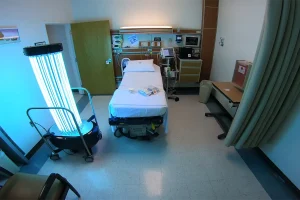
Proper UV-C dosage and microbial response is a discussion that has been ongoing for many years, regarding k-values, which are species-dependent inactivation rate constants for virus, bacteria and fungi. UV-C effectiveness depends on the UV-C dose delivered to microorganisms and viruses, which is simply the average irradiance multiplied by time. The k-value for a species can differ greatly depending on testing environment and reported k-values in literature for the different species of microorganisms and viruses and can vary over several orders of magnitude.
Unfortunately, no standard testing methods are available to determine accurate k-values; hence, simply using a k-value from literature may not be appropriate if this value was established under different environmental conditions than the actual application. What this means for the user of a mobile UV-C device is that the dosage delivered to a surface may not be sufficient to achieve the desired log reduction. Hence, the difficulty for the mobile device consumer has become to sort through manufacturer claims of device run time needed to inactivate specific pathogens to a certain log reduction. In most user environments, time equals money, and having a fast turnaround time for room cleaning (terminal cleaning) is a critical selling point between competing devices. The consumer needs to be aware that log reduction claims may use k-values that are lower than they should be to achieve a faster inactivation time.
Lamp performance matters
The question many consumers have been asking is how to validate the performance of their mobile UV-C device. One important aspect of any UV-C device is the lamp. Lamp quality, longevity and intensity output are critical considerations in purchasing any mobile UV-C device. Most mobile UV-C devices use low-pressure mercury lamps, which have been thoroughly studied. Their efficacy is well established in the industry. Most mobile devices use the germicidal wavelength of 253.7 nm due to its well-established k-values. However, some mobile devices entering the market also are producing the 185 nm wavelength, which generates ozone, an undesirable and unsafe feature for room disinfection applications.
It is critical to evaluate the mobile device as a whole, as many manufacturers utilize reflective material in the center, surrounded by the lamps, to enhance lamp intensity. Some run at maximum intensity, others, based on design, can run a selection of their lamps at maximum intensity. Some use two or three towers of lamps, and others have one tall stand-alone lamp. There are too many designs to list.
Other devices on the market utilize different lamp technologies, such as pulsed xenon and LED. Where some provide third-party test data, and others have little data. It is critical for the consumer to always inquire about third-party testing from an accredited lab without conflict of interest with the manufacturer of the device.
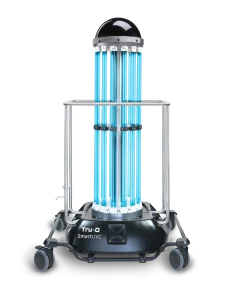
When the mobile UV-C industry first began to take off in healthcare settings across the US, approximately 12 years ago, device users had few means to validate device performance.
Radiometers often were cost-prohibitive when added to the device purchase cost, and simple dosimeters were not readily available. Today, dosimeters are becoming commonplace, as they can help provide, in a sense, a litmus test of device performance and can help establish most efficient run times by measuring the dosage delivered. In addition, they represent a good cross check to validate device performance. Some devices use sensors to measure, broadly speaking, the effective UV-C reflected back to the respective device from a surface. Others place remote sensors about the space, which may not require the help of a radiometer or dosimeter for validation.
Desired safety features
UV-C can be hazardous, and exposure should be avoided. Effects of UV-C exposure can include ocular damage, which begins with photokeratitis but also can result in photo keratoconjunctivitis. In addition, cutaneous damage that consists of erythema – a reddening of the skin like a sunburn – can occur after exposure. Many established mobile UV-C devices feature 360-degree safety sensors with various detectors and sensors that will immediately trigger the device in operation to shut off should a person enter the space. This is a particularly important feature in preventing accidental exposure and should be a mandatory component for all mobile UV-C devices.
Finally, to further protect from accidental exposure if device safety features are not available, a minimum of proper “UV in Use” door signs or barriers should be integrated.
Ease of use, training, serviceability and maintenance programs for UV-C mobile devices are all somewhat different, with various features and user interfaces, but most are easily learned, with preprogrammed pathogen inactivation features. Established companies offer extensive on-site and web-based training, certification and instructional videos, which are important in training any new user of UV-C. Unfortunately, many devices are being sold by distributors who do not offer training or additional assistance after the purchase, creating a potential hazard for the user.
Training often includes the basics of servicing the mobile device, as most do not require much more than scheduled lamp replacement. The more complex a device becomes, the more involved and costly repairs can become. If sensors are part of the device, scheduled calibrations are critical to ensure device efficacy. Some device manufacturers offer monthly service programs. Service programs greatly add to the cost of these devices, and consumers should use care when evaluating what is included and/or why some manufacturers require such programs. These monthly service fees should be considered when comparing the total cost of ownership.
Due diligence and employee buy-in is important
Mobile UV-C devices offer an effective adjunct to manual cleaning and can reach surface areas that are harder to clean or that are simply overlooked by the environmental services. However, they represent a big financial investment, and the proper device must be chosen for each individual environment. This decision requires considerable deliberation. One of the most important issues can be that the C-suite decides to make a purchase without employee buy-in, leading to non-use. This can be the case in environmental services, where frontline employees may feel the angst of being replaced by a UV-C robot and/or afraid to break such an expensive machine. Including staff in these decisions and testing devices before making a purchasing decision may be a good solution. A trial allows proper device evaluation before committing to such a large purchase. Most established mobile UV-C companies offer trial programs for this reason.
The emergence of UV-C as one of the primary tools to help combat the COVID-19 pandemic has become extremely valuable. At the same time, it is critically important for the consumer to ask the right questions before purchasing a device. Misleading brochures can lead to the purchase of the wrong device. Spending extra time doing research on the various devices is a valuable step before making any buying decisions.
Contact: Katja Auer, [email protected]

